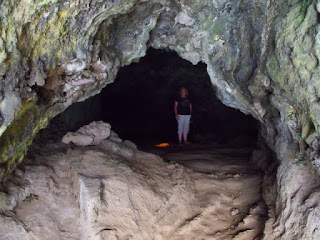The West Coast Loop
Day Four
Today we decided to do a loop of the West coast that took in some caves, Ahu and the topknot quarry.
First stop of the day, Ahu Huri A Urenga, one of 25 inland platforms.
 |
| Ahu Huri A Urenga |
This Moai is interesting as it has 2 pairs of hands and an astronomical orientation (the statue faces the exact direction of the rising sun at the winter solstice - June 21st).
 |
| Aligned to the winter solstice |
Near Ahu huri A Urenga is the topknot quarry called Puna Pau. The quarry is a small volcanic crater made up of red scoria stone.
 |
| Topknots awaiting transportation |
Topknots are finished at the platform, so all the topknots in the quarry are cylindrical.
The next topknot was modified by a resourceful shepherd who wanted shelter from the wind.
Just like the Moai, the topknots were carved while still attached to the bedrock.
 |
| The crater at Puna Pau |
 |
| The view from Puna Pau - looking towards Hanga Roa |
 |
| The view from Puna Pau - looking inland |
Next stop another inland platform called Ahu Akivi or the 'seven Moai'.
 |
| Ahu Akivi - Front view |
 |
| Ahu Akivi - Rear View |
The volcanic legacy of the island is a number of former lava tubes, many of which have been inhabited in the past. The first lava tube of the loop was Ana Te Pahu. Ana Te Pahu stretches for over 1 km in length and is often referred to as the 'Banana Cave' as there are many banana trees that have recently been planted in the cave opening.
 |
| The pile of stones are a bed! They did cover the stones with dry grass and feathers. |
 |
| Walls were built inside the caves and acted as windbreaks |
 |
| At the entrance of the cave plants and trees were grown. |
 |
| Banana Trees |
Next stop was another platform (Ahu Te Peu), this one was unrestored and on the coast. The site shows evidence of habitation and the remains of the largest boat house found (40 m long).
 |
| Foundations of a boat house. You can see the post holes that have been carved into the blocks. |
 |
| Head of a toppled Moai |
 |
| Another Moai head. |
Even though the Moai were destroyed the platform was left intact. The stonework is similar to that of the Inca.
Travelling South, towards Hanga Roa, along the West coast brought us to Ana Te Pora another cave. This one as open to the elements.
 |
| Hat! |
Continuing South we arrived at another lava tube, this one was different as it had two lava flows through the cliffs and is also known as the 'Two Windows' cave. A bit of a squeeze but well worth it. Below are the views from one of the windows.
Looking into the lava tube from the second window.
 |
| The walls and ceiling are formed from low-viscosity lava that formed a hard crust on cooling. |
Just as we pulled up at the last site of the day - Te Pu Haka Nini Te Mako'i it started to rain. We waited in the car but the rain was in for the long hall so it was time to head back to the tent and await the sunset. Here are a number of the photos we took at sunset.
 |
| Looking East |
 |
| Looking South |
 |
| Looking North |
 |
| The surf is up! |
 |
| The waves come rolling in! |
 |
| Looking East again. |
Don't forget to check out the final instalment.































 r
r
































